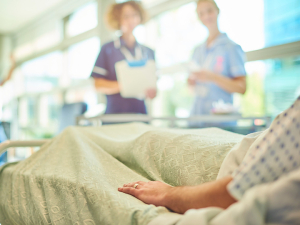Efforts to re-engineer delivery of care recognized by Harris Health
Industrial engineers work to improve system performance, whether that system is in an oil refinery or an automobile production line or, as in this case, in hospitals.
A collaboration between the University of Houston and the Harris Health System Center for Innovation offered undergraduate and graduate students with the UH Department of Industrial Engineering department an opportunity to help solve a real-world problem in a hospital emergency center.
Suresh Khator, professor of industrial engineering and associate dean for graduate programs and computing facilities in the UH Cullen College of Engineering, and Dr. Stephen Spann, founding dean of the UH College of Medicine, were recognized earlier this month at the Harris Health System Innovation Summit for a project to improve the flow of psychiatric patients through the emergency center at Ben Taub Hospital.
Khator said the project grew from conversations between Spann and Harris Health executives and began last fall with undergraduate students in his simulation science class studying patient flow and talking with hospital staff to understand how things worked.
“We don’t have domain knowledge,” Khator said. “We are not doctors. We look at the situation and study, where are the bottlenecks? Where are people waiting in line? What can we do to increase efficiency and productivity?”
Shanna Doucet, director of Care Management and Innovation at Harris Health, said the public health system is interested in innovative thinking to improve patients’ experiences.
Health care engineering isn’t new, she said, but the benefits are still emerging.
“More hospitals are collaborating with engineers to look at how to streamline operations, how to be more efficient,” she said. “There are more opportunities for engineers as we look at the human factors that are impacting how we operate.”
Khator’s spring class, made up of graduate students, has continued the project.
Poria Dorali, a doctoral student in industrial engineering, said he and other graduate students have gathered patient information and other data, as well as spent time in the waiting room and outside the hospital, observing and talking with patients. The information will be added to a computer model, allowing them to incorporate proposed changes – adding a staff member, for example, or combining some functions – to determine the impact.
It is a challenging problem, he said. “No two patients have the same problem. The steps that need to be taken are different for each patient.”
Khator said the Harris Health collaboration allows students to work with a cross-disciplinary team on a real problem, rather than a theoretical issue.
“We’re not Google or Microsoft programmers, where you go in your cubicle and write code,” he said. Engineers solve problems, and that generally requires working with a group of people.
Dorali sees another benefit.
“We’ve experienced it firsthand,” he said. “We see patients waiting. This is an opportunity to help the community and make a difference.”
